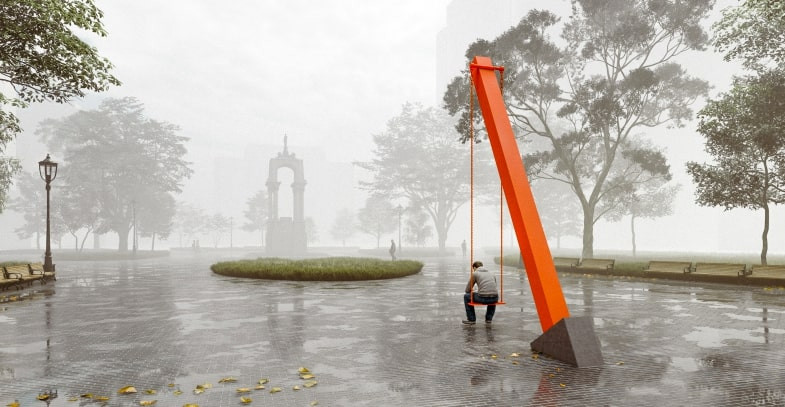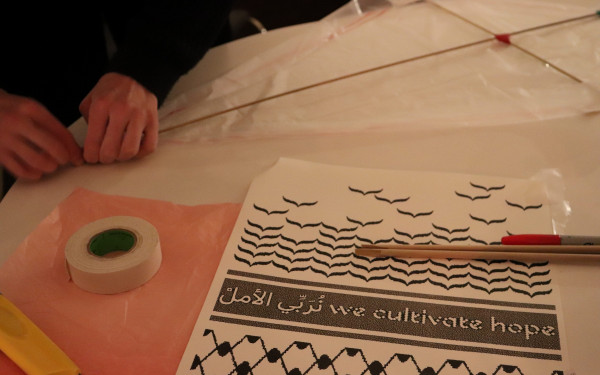Design contest generates ideas on how to replace toppled John A. Macdonald statue
Winning submission of the 2021 CCA Charrette centres children that died in residential schools.
Winners of this year's special edition Canadian Centre of Architecture Charrette were announced on Nov. 17 in a virtual awards ceremony.
Around forty people attended, among them the winners, other contestants, and members of the jury. This charrette, an event aimed at solving a problem, was organised in collaboration with the interuniversity research group After Macdonald. This is a group of artists, professors and others involved in art policy that was formed to tackle the issue of replacing Place du Canada's John A. Macdonald statue toppled in May 2020.
Thirty one teams of students signed up for the charrette but only 18 submitted an intervention, a design meant to repurpose the plinth. They were tasked with creating an intervention that would sit on the now empty plinth, the pedestal that once held the Macdonald statue.
David Theodore, one of the three members of the jury, announced the winners. The first place intervention, called Balançoire, was designed by Lisa Hadioui, Juan Fernando Barrionuevo, and Kamelia Djennane; three students of architecture from Université de Montréal. Their intervention is a swing meant to commemorate the lives of the thousands of Indigenous children that died in residential schools.
“It was a very engaging exercise and I really do appreciate the opportunity to do this. It was really an opportunity to think over the issues and plunge deep into our emotions and try to deal with that at the same time,” said Hadioui before thanking the CCA for organising the event. “The process was very simple. We only needed the essentials which were metaphor, emotion, and poetry.”
Christopher Clark McQueen and Marcela Torres got a special mention for their proposition to use the site as a memorial of all the Indigenous children that went to residential schools. McQueen said that the process for his intervention was to reflect on the transition of the children before and after colonisation. His grandmother was a residential school survivor and his mother went to Indian Day School.
The charrette was first started in 1994. Yimi Poba-Nzaou, the Canadian Centre of Architecture’s coordinator of public collaborations, said that its goal is to engage with students of architecture and related disciplines to hear their new ideas about the intersection of architecture and society. She said that the purpose of this year’s charrette was to create a temporary intervention to challenge the way the public thinks about the permanence of history.
“The monuments that we have, for the most part, celebrate historical figures like [John A. Macdonald] without acknowledging their responsibility in systemic racism or the people who have to endure the consequences of their policies,” she said. “This year, the proposal was for students to think about what it would mean to have a different way of thinking about how we memorialise our history.”
Natalia Gulick de Torres, one of the jury members, congratulated the participants in a statement for creating propositions that boldly challenged preconceived notions of history. She acknowledged that their task of creating a monument that addressed the painful history of colonialism in a decolonial way was difficult. “All faced the difficult task of creating a site-specific intervention that acknowledged this painful history while bringing a sense of decolonial ethics to the contemporary site. “Not an easy feat, especially given the condensed time frame. Yet, it was striking to see the volume of high quality proposals.”
This year's charrette was the first to be opened to students from all disciplines and international contestants. The CCA received applications from contestants in the United States, South Africa, and Bangladesh.
Poba-Nzaou says that even though the statue was specific to the Canadian context, it’s significance transcends borders.
“The subject about [tackling] colonial history is a topic that is relevant all over the world. At the time the statue was being taken down in Montreal, many statues were being taken down of colonial figures and people who participated in slavery,” she said.
While the charrette engaged with the idea of replacing the John A. Macdonald statue on a purely theoretical level, Patrick Stewart, a jury member, said the charrette could allow a conversation with the Canadian Centre of Architecture and the city to be had about actually replacing the statue.


_600_832_s.png)


-10_600_375_90_s_c1.jpg)

